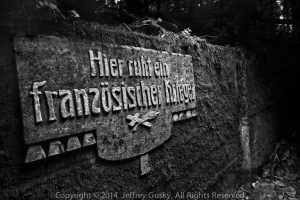New Image Captures Unknown WWI German Tribute to Fallen French Soldier
Dr. Jeff Gusky Releases The Hidden World of World War I to Mark the 100th Anniversary of the Beginning of the War
 DALLAS (July 31, 2014) — To mark the launch of the 100th anniversary World War I, photographer Dr. Jeff Gusky is releasing a never-before-seen photograph of an original wartime plaque crafted by German soldiers in honor of a French soldier who died and was buried directly in front of their trench. The photograph is part of Gusky’s just-released collection: The Hidden World of World War I.
DALLAS (July 31, 2014) — To mark the launch of the 100th anniversary World War I, photographer Dr. Jeff Gusky is releasing a never-before-seen photograph of an original wartime plaque crafted by German soldiers in honor of a French soldier who died and was buried directly in front of their trench. The photograph is part of Gusky’s just-released collection: The Hidden World of World War I.
Located inside an original German front line trench, the tribute reads “Here lies a French combatant”. The term “combatant” conveys respect for the fallen French soldier while the cross at the bottom of the plaque expresses reverence for a noble adversary; sentiments which seem out-of-place in a theater of slaughter.
Jeff Gusky tells the story of this photograph in this video.
Gusky photographed this plaque in 2014, in a remote sector of the Vosges Mountain battlefield of Hartmannswillerkopf where more than 30,000 soldiers died. And while deaths were commonplace, memorializing the enemy — particularly with such dignity — was not. Gusky has conferred with experts who believe that this plaque is the only such tribute in existence along the entire Western Front.
On August 3, 2014, French President François Hollande and German President Joachim Gauck will launch the 100th anniversary of World War I with a handshake over the former front line at Hartmannswillerkopf, demonstrating the peace and mutual respect that the two countries enjoy today. Jeff Gusky’s photograph is a visual icon of that handshake.
This groundbreaking image comes from Jeff Gusky’s search for hidden remnants of WWI and is part of a collection of over 2,000 photographs titled The Hidden World of WWI. The Dallas photographer and emergency physician spent several years cultivating relationships with local WWI experts and landowners all along the Western Front to gain access to never-before-seen traces of the war. He has photographed miles of subterranean spaces and obscure artifacts on the surface, gaining valuable insight into the inner lives of soldiers from many nations.
All but unknown to the outside world, soldiers from both sides of the conflict left messages to the future in ancient underground rock quarries that were converted to subterranean cities beneath the trenches. Tens of thousands of men lived in these cities underground. They created breathtaking works of art and inscribed emotional graffiti that have survived to the present as if 100 years was yesterday.
Like this awe-inspiring tribute by front line German soldiers to a fallen French adversary, all of Jeff Gusky’s work challenges the modern viewer to see past stereotypes and engage with the personal testimonies soldiers carved in stone a century ago.
Gusky observed that what the soldiers left behind is “less about war, and more about how they struggled to remain human while living through the world’s first modern destruction.” While the details of the story behind the German plaque honoring the life of a fallen French soldier have likely been lost to history, the impulse to commemorate a noble death — even in the midst of the horrors of battle — provides a glimpse into the humanity of the soldiers, even as they engaged in mass destruction.
Jeff Gusky’s discoveries and photographs are featured in the August 2014 issue of National Geographic Magazine: The Hidden World of the Great War.
Images from The Hidden World of WWI can be found at jeffgusky.com. Follow The Hidden World of WWI on Twitter, on Instagram or on Facebook.
About the Artist
Jeffrey Gusky, M.D., FACEP, lives two lives — one as a rural emergency physician and the other as a fine-art photographer and explorer.
His first year of medical school at the University of Washington was spent in Alaska as part of the WAMI Program, created to inspire students to become country doctors. Jeff Gusky graduated high in his class and was inducted into Alpha Omega Alpha, the National Honor Medical Society. He combined his love of flying and rural medicine and used his plane to reach remote hospital emergency rooms on short notice throughout Texas and Oklahoma. Since 1991, he has taught trauma skills to other physicians as an instructor in the Advanced Trauma Life Support program and is a fellow of the American College of Emergency Physicians.
Two books of black-and-white photography, multiple national exhibitions including the pairing of his work with the Spanish master Francisco de Goya and the legendary early 20th Century photographer Roman Vishniac, inclusion in a Broadway play and the honor of a Gusky traveling exhibition being ranked by Artnet Magazine on its 2009 list of the top 20 museum shows in America mark Jeff Gusky’s fine-art career. He explores the world — photographing pieces of the past that can help us discover who we are and which inspire us to ask questions about the vulnerabilities of modern life that we have forgotten how to ask.
Media: Downloadable images available at jeffgusky.com/press-room
###
Media contacts:
Dana Cobb, TrizCom Inc.
Office: 972-247-1369
Cell: 972-955-9747
danacobb@trizcom.com
Katie Hill, TrizCom Inc.
Office: 972-247-1369
Cell: 214-676-4254
katie@trizcom.com
